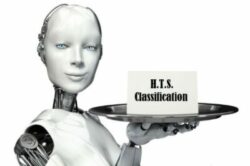By: Bonnie Kersch, Senior Trade Advisor, Braumiller Consulting Group
Are the robots taking over? Last week, I stopped by McDonalds, placed my order on a computer, pulled out my phone and used an app to make a doctor’s appointment, and then later deposited a check through a different app on my phone. All of these jobs that used to be performed by humans are now being taken over by technology. Should we be concerned, as Global Trade professionals, that classifying will be too?
Not anytime soon.
There are several products on the market that offer classification services where a computer program will scan your parts list and spit out a classification like magic. These programs seem like a good way to go because they’ll save you time and money. That’s what the boss wants to hear, so sign me up!
Not so fast.
One company says that they’ve “…invested in intelligent machine-learning algorithms based on the millions of items [they’ve] examined previously.” A computer program is only as good as the information that you feed into it. Insert one bad number into a spreadsheet full of formulas, and your whole calculation is off. The same is true for classification. I have yet to work with a company who has all of the information that I need to classify ready and waiting at my fingertips. Not every bill of materials will list everything needed for classification. You may find that you’ll spend more time gathering the information that the “intelligent machine-learning algorithm” needs than you would spend classifying the product yourself.
Classification is not an easy task. Take for example, this recent list I was given to classify:
Part # 123 – Pin
Part # 234 – Pin
Part # 345 – Pin
It seems like they should all be classified the same, right? Wrong! The first one was a pin classified in 7318.24, the second was a cotter pin in 7318.29, and the third was a hinge pin classified in 8302.10. Would a computer program be able to pick up on the nuances of these pins and realize that they are not all the same? Not without more information from you.
There’s also the issue of Reasonable Care. Reasonable Care is the guideline that Customs requires companies to follow. It’s what draws the line between “you clearly did all you could to get to the right answer” and a negligence violation. CBP reminds us in their Informed Compliance Publication “Reasonable Care” that, “An importer of record’s failure to exercise reasonable care could delay release of the merchandise and, in some cases, could result in the imposition of penalties or, in certain instances, referral for criminal enforcement.” Is allowing a computer program to classify one’s goods exercising Reasonable Care? If a human is reviewing the classifications that the program suggests, then I would argue that Reasonable Care has been demonstrated. However, if a company relies solely on artificial intelligence to provide its classification, Reasonable Care has not been fulfilled, and this leaves the company at risk for serious penalties.
Ultimately, there is no substitute for a human being when it comes to classification. If a company can hire a Licensed Customs Broker to perform its classification duties, that’s fantastic. At times, when the classification work is too much to handle, or too difficult, reaching out to a team of classification professionals, like those that can be found at Braumiller Consulting, is another great option, and is definitely a demonstration of Reasonable Care.

